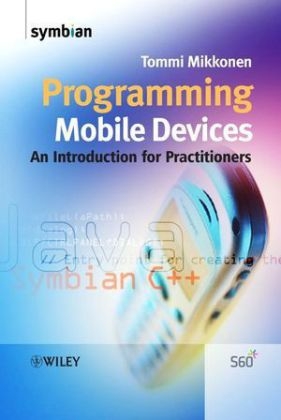
Programming Mobile Devices
John Wiley & Sons Inc (Verlag)
978-0-470-05738-4 (ISBN)
With forewords by Jan Bosch, Nokia and Antero Taivalsaari, Sun Microsystems. Learn how to programme the mobile devices of the future!
The importance of mobile systems programming has emerged over the recent years as a new domain in software development. The design of software that runs in a mobile device requires that developers combine the rules applicable in embedded environment; memory-awareness, limited performance, security, and limited resources with features that are needed in workstation environment; modifiability, run-time extensions, and rapid application development.
Programming Mobile Devices is a comprehensive, practical introduction to programming mobile systems. The book is a platform independent approach to programming mobile devices: it does not focus on specific technologies, and devices, instead it evaluates the component areas and issues that are common to all mobile software platforms. This text will enable the designer to programme mobile devices by mastering both hardware-aware and application-level software, as well as the main principles that guide their design.
Programming Mobile Devices:
Provides a complete and authoritative overview of programming mobile systems.
Discusses the major issues surrounding mobile systems programming; such as understanding of embedded systems and workstation programming.
Covers memory management, the concepts of applications, dynamically linked libraries, concurrency, handling local resources, networking and mobile devices as well as security features.
Uses generic examples from JavaTM and Symbian OS to illustrate the principles of mobile device programming.
Programming Mobile Devices is essential reading for graduate and advanced undergraduate students, academic and industrial researchers in the field as well as software developers, and programmers.
Tommi Mikkonen is a professor of software engineering at Tampere University of Technology. He has been the head of the Institute of Software Systems since 2002, and has been responsible for numerous research projects as well as supervised a number of thesis works. His research interests include DisCo, Practise, software evolution, mobile systems, distributed systems, software architectures, and aspect-oriented software development.
Foreword by Jan Bosch xi
Foreword by Antero Taivalsaari xv
Preface xvii
Acknowledgments xxi
1 Introduction 1
1.1 Motivation 1
1.1.1 Leaking Abstractions 1
1.1.2 Allocation Responsibility 3
1.2 Commonly Used Hardware and Software 4
1.2.1 Computing Hardware 5
1.2.2 Low-Level Software Infrastructure 13
1.2.3 Run-Time Infrastructure 14
1.2.4 Software Stack 20
1.3 Development Process 21
1.4 Chapter Overview 23
1.5 Summary 25
1.6 Exercises 25
2 Memory Management 27
2.1 Overview 27
2.2 Strategies for Allocating Variables to Memory 27
2.2.1 Static Allocation 28
2.2.2 Stack 28
2.2.3 Heap 30
2.3 Design Patterns for Limited Memory 31
2.3.1 Linear Data Structures 31
2.3.2 Basic Design Decisions 32
2.3.3 Data Packing 34
2.3.4 Discussion 36
2.4 Memory Management in Mobile Java 37
2.4.1 Motivation 37
2.4.2 Rules of Thumb for Mobile Java 39
2.5 Symbian OS Memory Management 42
2.5.1 Naming Conventions 43
2.5.2 Descriptors 45
2.5.3 Exceptions 46
2.5.4 Combining Exceptions and Allocation 48
2.5.5 Cleanup Stack 49
2.5.6 Two-Phase Construction 52
2.5.7 Factory Methods for Two-Phase Construction 54
2.5.8 Using Symbian Conventions 55
2.6 Summary 57
2.7 Exercises 58
3 Applications 61
3.1 What Constitutes an Application? 61
3.2 Workflow for Application Development 62
3.2.1 Scoping 63
3.2.2 Performance Considerations 63
3.2.3 User Interface Design 64
3.2.4 Data Model and Memory Concerns 65
3.2.5 Communications and I/O 65
3.3 Techniques for Composing Applications 66
3.3.1 Event-Based Programming 67
3.3.2 Model-View-Controller as the Application Architecture 68
3.3.3 Auxiliary Files 70
3.3.4 Managing Applications 71
3.3.5 Practicalities 73
3.4 Application Models in Mobile Java 73
3.4.1 Configurations 74
3.4.2 Profiles 76
3.4.3 Sample MIDP Java Application 80
3.5 Symbian OS Application Infrastructure 84
3.5.1 Overview 85
3.5.2 Resource File 86
3.5.3 Attaching Application to Run-Time Infrastructure 88
3.5.4 Application 89
3.5.5 Document 91
3.5.6 User Interface 93
3.5.7 View 96
3.5.8 Engine 98
3.5.9 Generating Installation Package 102
3.6 Summary 102
3.7 Exercises 103
4 Dynamic Linking 105
4.1 Overview 105
4.1.1 Motivation 105
4.1.2 Release Definition Using Dynamically Linked Libraries 106
4.1.3 Required Implementation Facilities 107
4.1.4 Static versus Dynamic DLLs 107
4.1.5 Challenges with Using DLLs 108
4.2 Implementation Techniques 109
4.3 Implementing Plugins 111
4.3.1 Plugin Principles 111
4.3.2 Implementation-Level Concerns 113
4.4 Managing Memory Consumption Related to Dynamically Linked Libraries 114
4.4.1 Memory Limit 114
4.4.2 Interface Design Principles 115
4.4.3 Merging Elements 117
4.5 Rules of Thumb for Using Dynamically Loaded Libraries 118
4.6 Mobile Java and Dynamic Linking 118
4.7 Symbian OS Dynamic Libraries 120
4.7.1 Standard Structure of Dynamically Linked Libraries 120
4.7.2 Managing Binary Compatibility 122
4.7.3 ECOM Component Model 124
4.8 Summary 125
4.9 Exercises 126
5 Concurrency 127
5.1 Motivation 127
5.2 Infrastructure for Concurrent Programming 127
5.2.1 Threading 128
5.2.2 Inter-Thread Communication 128
5.2.3 Common Problems 129
5.3 Faking Concurrency 130
5.4 MIDP Java and Concurrency 132
5.4.1 Threading in Virtual Machine 132
5.4.2 Using Threads in Mobile Java 132
5.4.3 Problems with Java Threading 135
5.5 Symbian OS and Concurrency 135
5.5.1 Overview 135
5.5.2 Sample Active Object 141
5.5.3 Active Objects and Applications 145
5.5.4 Problems with Active Objects 145
5.6 Summary 146
5.7 Exercises 147
6 Managing Resources 149
6.1 Resource-Related Concerns in Mobile Devices 149
6.1.1 Overview 149
6.1.2 Grouping Resource Managers 151
6.1.3 Separating Resource Managers 152
6.1.4 Resource-Hosting Virtual Machine 155
6.2 Common Concerns 156
6.2.1 Overview 156
6.2.2 Extension and Adaptation 156
6.2.3 Performance 158
6.2.4 Energy Management 159
6.2.5 Internal Resource Management 160
6.3 MIDP Java 161
6.3.1 Basic Elements 162
6.3.2 Compatibility between Different Devices 164
6.4 Symbian OS 165
6.4.1 Servers as a Mechanism of Resource Management 165
6.4.2 Implementing Servers 167
6.4.3 Adapting Servers to Hardware 171
6.4.4 Problems with Servers 173
6.5 Summary 173
6.6 Exercises 174
7 Networking 177
7.1 Introduction 177
7.1.1 Basic Connectivity 177
7.1.2 Stateful and Stateless Systems 178
7.1.3 Infrastructure Assisted or Ad-hoc Networking? 180
7.2 Design Patterns for Networking Environment 181
7.3 Problems with Networking Facilities and Implementations 184
7.4 MIDP Java and Web Services 185
7.4.1 Web Services Overview 185
7.4.2 Using Web Services with Mobile Java 187
7.5 Symbian OS and Bluetooth Facilities 189
7.5.1 Bluetooth Introduction 189
7.5.2 Bluetooth in Symbian 191
7.6 Summary 194
7.7 Exercises 194
8 Security 197
8.1 Overview 197
8.2 Secure Coding and Design 198
8.2.1 Mindset for Secure Design 198
8.2.2 Sample Security-Related Design Patterns 199
8.3 Infrastructure for Enabling Secured Execution 201
8.3.1 Goals for Security Features 201
8.3.2 Supporting Hardware and Software Facilities 203
8.4 Security Features in MIDP Java 205
8.4.1 Low-Level Security 205
8.4.2 Application-Level Security 206
8.4.3 End-to-End Security 208
8.4.4 Problems 208
8.5 Symbian OS Security Features 208
8.5.1 Low-Level Security 209
8.5.2 Application-Level Security 209
8.5.3 End-to-End Security 211
8.5.4 Problems with Symbian OS Security Features 212
8.6 Summary 212
8.7 Exercises 213
References 215
Index 219
| Erscheint lt. Verlag | 19.3.2007 |
|---|---|
| Verlagsort | New York |
| Sprache | englisch |
| Maße | 176 x 249 mm |
| Gewicht | 624 g |
| Einbandart | gebunden |
| Themenwelt | Mathematik / Informatik ► Informatik |
| Technik ► Elektrotechnik / Energietechnik | |
| Technik ► Nachrichtentechnik | |
| ISBN-10 | 0-470-05738-6 / 0470057386 |
| ISBN-13 | 978-0-470-05738-4 / 9780470057384 |
| Zustand | Neuware |
| Haben Sie eine Frage zum Produkt? |
aus dem Bereich


